The EB-5 Immigrant Investor Program
It is an emplyment-based immigration program that allows foreign nationals to obtain lawful permanent resident status in the United States by investing in commercial enterprise that create jobs. The EB-5 stands for Employment-Based, Fifth Preference. The EB-5 Program highlights the purpose to attract foreign investment to boost the U.S. economy and create jobs.
The EB-5 Visa Process
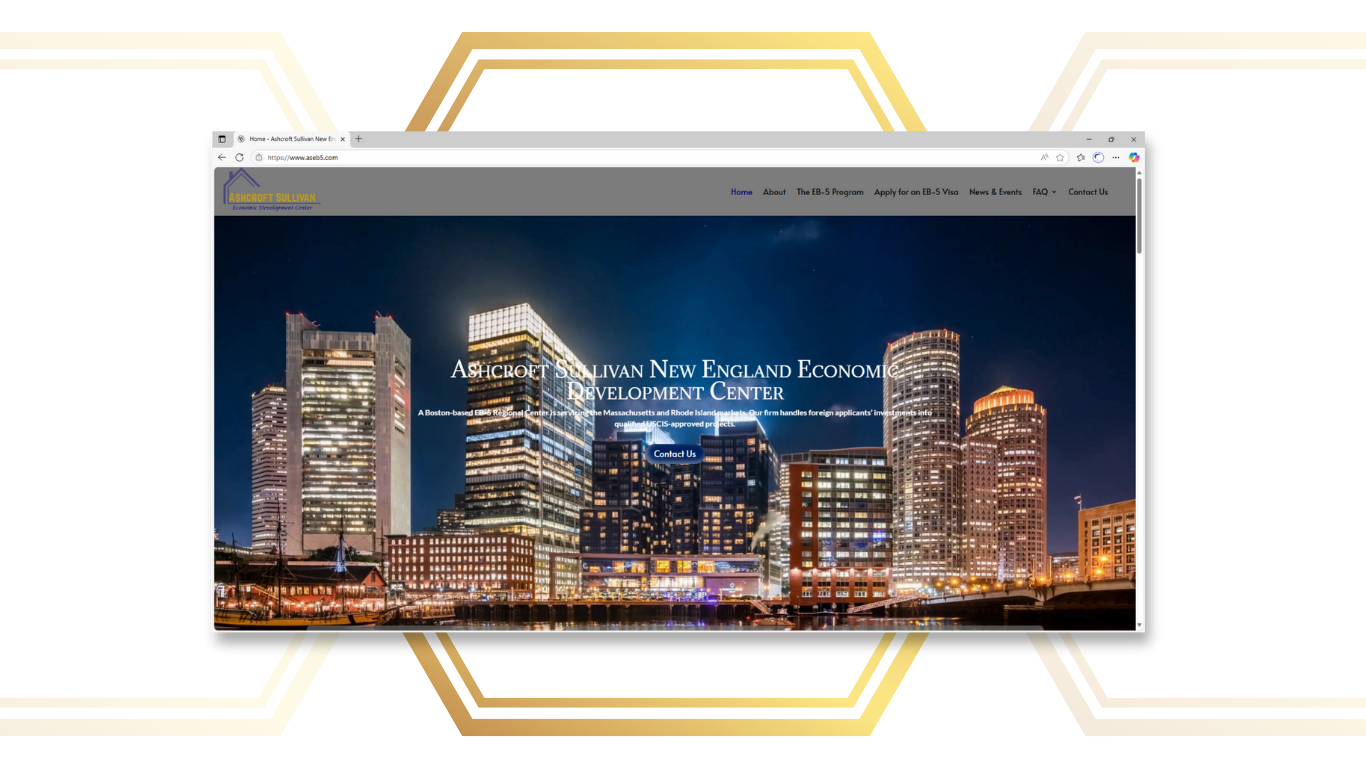
Research EB-5 Regional Center
EB-5 investors are advised to conduct comprehensive due diligence on Regional Centers across the United States. Applicants should carefully evaluate EB-5 Regional Centers based on their project portfolio, historical performance, management team qualifications, and offering documentation. It is essential that investors have confidence in the designated Regional Center responsible for managing both their investment and application process. The Ashcroft Sullivan New England Economic Development Center serves as an approved EB-5 Regional Center located in Boston, MA.
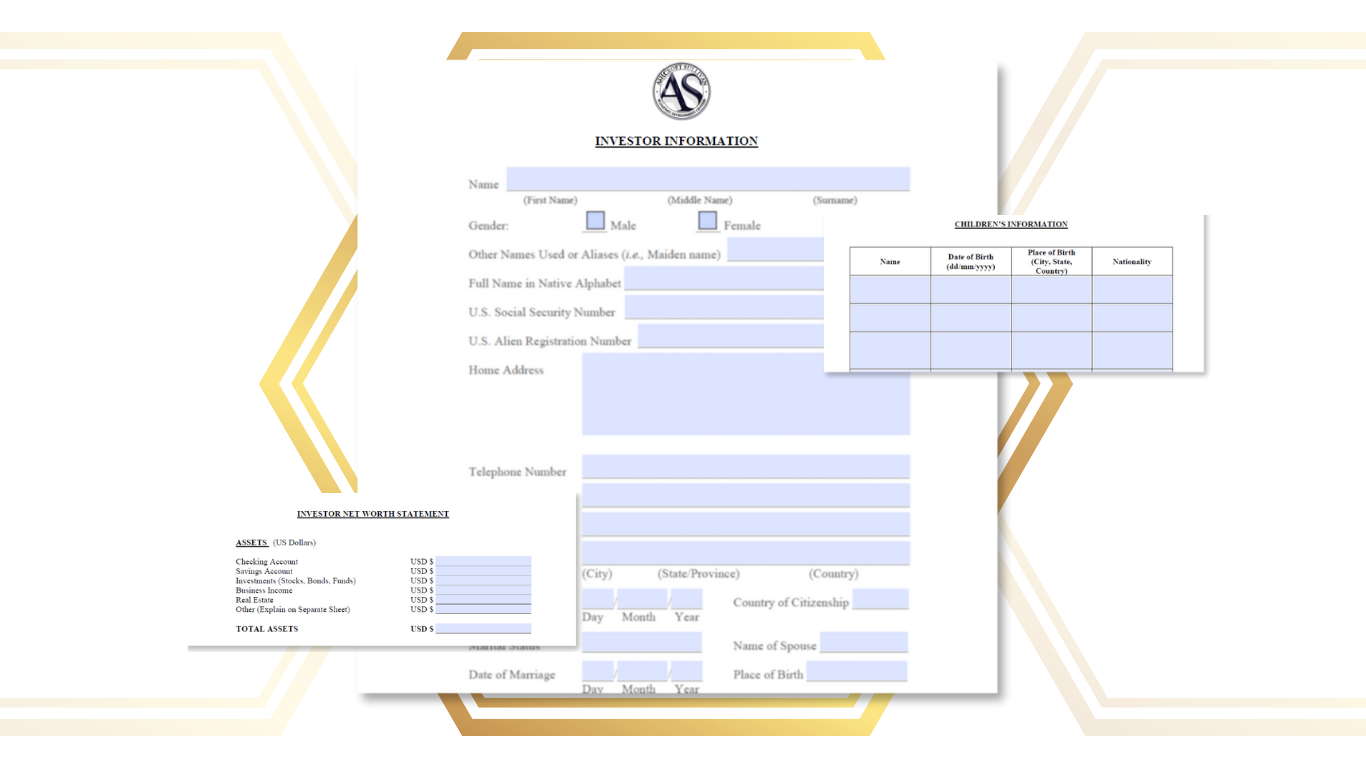
Investor Questionnaire
Individuals or families interested in the EB-5 Immigrant Investor Program are encouraged to complete the Ashcroft Sullivan New England Economic Development Center investor questionnaire. This questionnaire enables our experts to assess your eligibility and maximize your potential for success during the EB-5 Visa application process. By completing this step prior to committing the required investment of $800,000 or $1,050,000, you can reduce associated risks and make informed decisions regarding your investment with our firm.
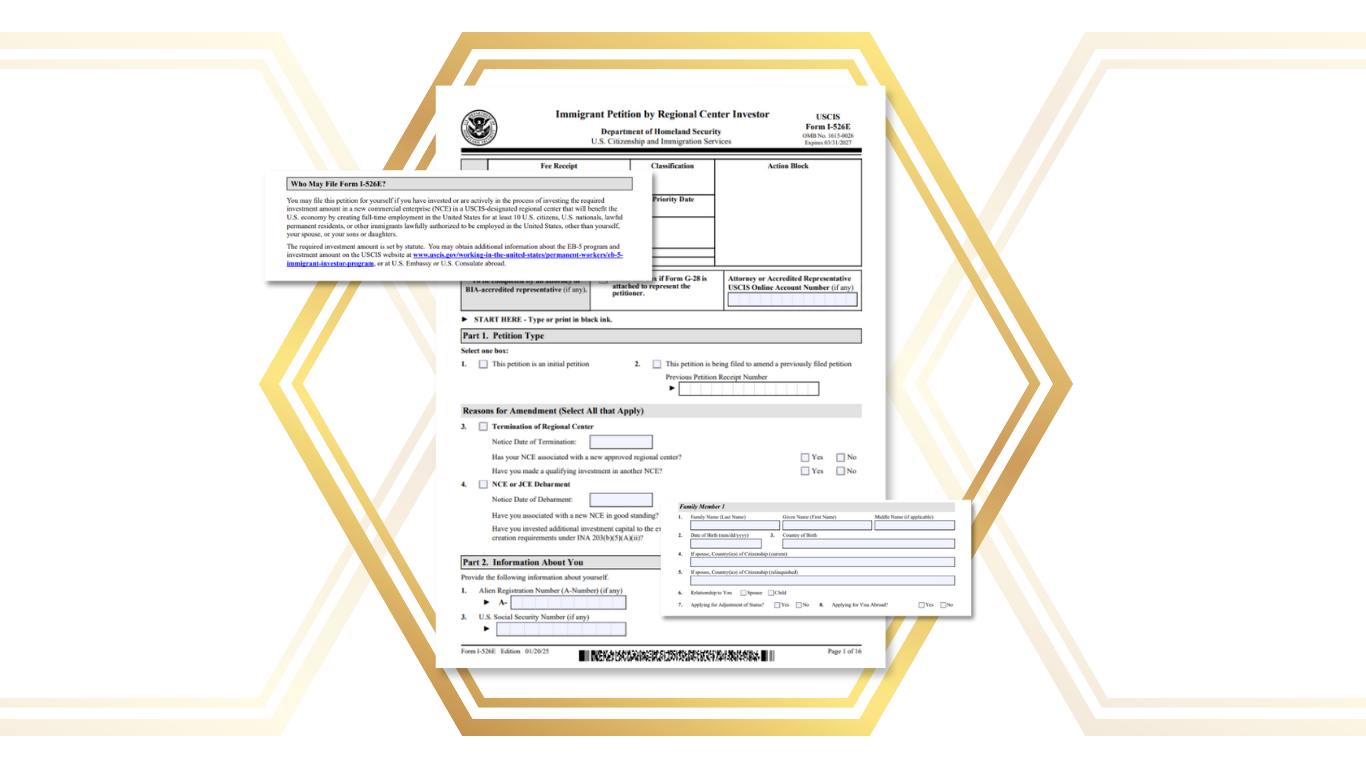
I-526 Application
Form I-526E, Immigrant Petition by Regional Center Investor, is a document used by foreign investors applying for a U.S. green card through the EB-5 Immigrant Investor Program. The I-526E is the first document completed in the EB-5 journey which can take up to or greater than 12 months for approval.
This document is started after completion and acceptance of the EB-5 Questionnaire. The investor will need to engage an immigration attorney to assist and file the I-526E paperwork to USCIS. If the applicant does not have or know an immigration attorney than the Ashcroft Sullivan New England Economic Development Center can introduce you to one.
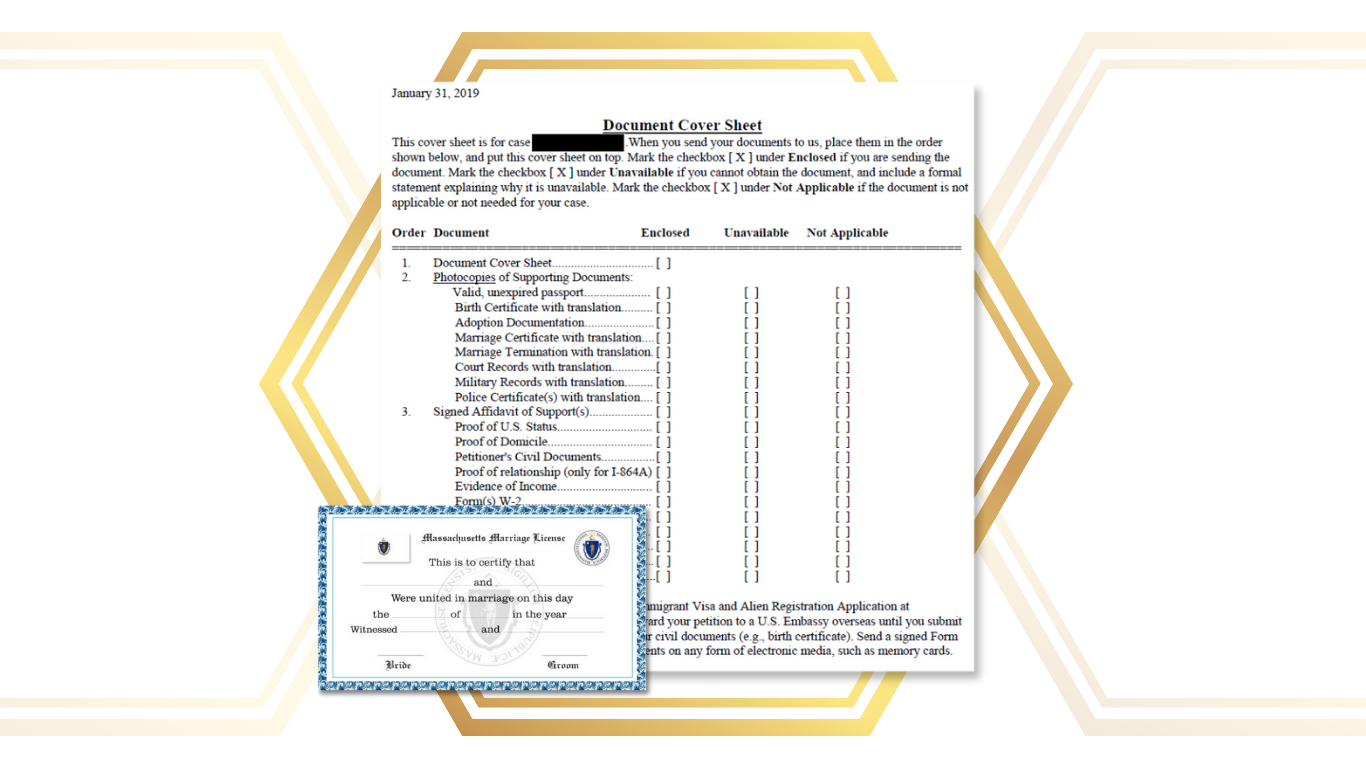
DS-260: Application for Immigrant Visa and Alien Registration
Once your I-526E is approved by USCIS, then the National Visa Center ("NVC") will issue a letter requesting certain evidence from the applicant and his or her family members. This information mostly consists of personal information. Investor can plan and prepare to provide the following information once submitting their DS-260 form; valid passport, birth certificate, police certificate(s), military records, marriage certificate, adoption documents, and possibly court records. In addition, the investor should be ready to pay a $345* application fee at this time for themselves and anyone else completing the EB-5 application.
*Please note this fee is subject to change and issued by the US government. This fee is not determined by the EB-5 Regional Center.
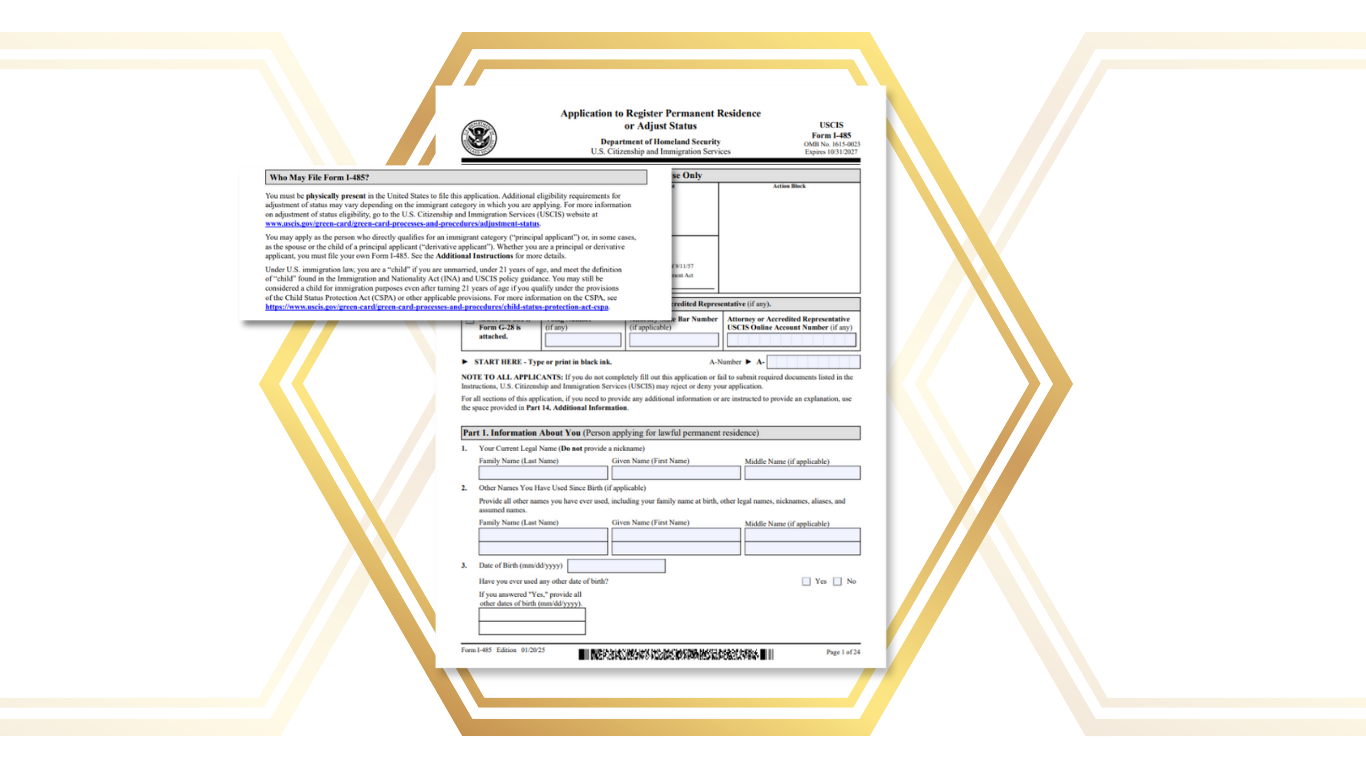
I-485: Application to Register Permanent Residence or Adjust Status
The form I-485 can be completed at the time of filing your I-526E or later if an immigrant visa is immediately available to you. So, if you are already in the United States through another Visa program than you can file form I-485 adjustment status for the EB-5 visa process. This application typically cost $1,440; however, it can change depending on age and your current visa documents. This does not include attorney fees.
*This price is enforced and changed by USCIS. Regional Center's do not have any control over the application cost.
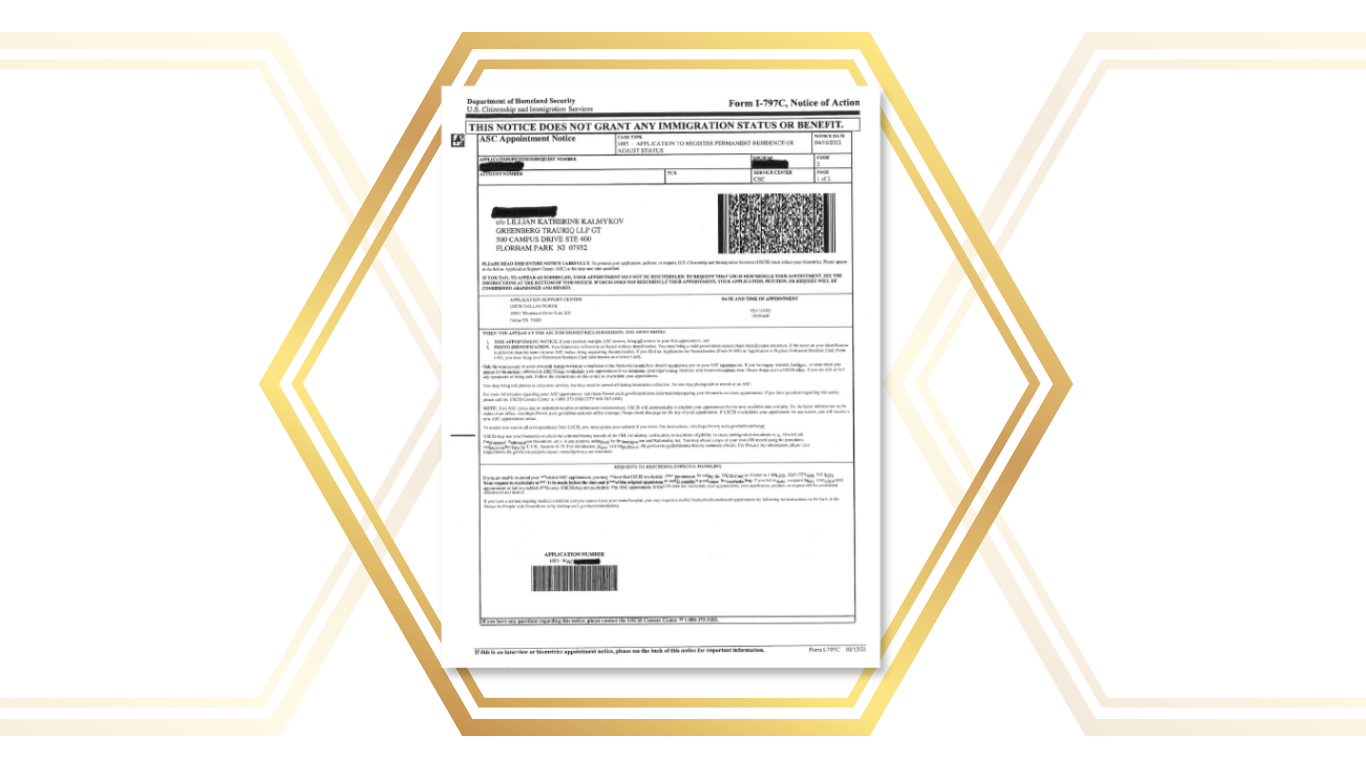
Consular Processing
The EB-5 Consular Processing comes once you complete your DS-260 paperwork. USCIS sends the applicant and attorney of record an email or letter which states the date of your interview at your local consulate. There are a limited number of items the applicant must bring with them and their family, but the most important piece is the Medical Examination. There are authorized doctors and location the EB-5 applicant can chose from. This ensures that you meet U.S. health standards.
Additional documents will be required such as interview appointment letter, source of funds, use of funds, DS-260 confirmation page, and all civil documents you submitted for the DS-260. The interviewer may ask for proof of investment, funds moved to the project, and your knowledge on the project. These questions are subject to change with each interviewer.
At this time, you will be approved, or they will request additional information. If approved, you will be issued a temporary green card which you have 90 days to move to the United States. Once the applicant enters the United States, he or she will be issued the conditional green card. The conditional green card is for 2 years from the date of entry.
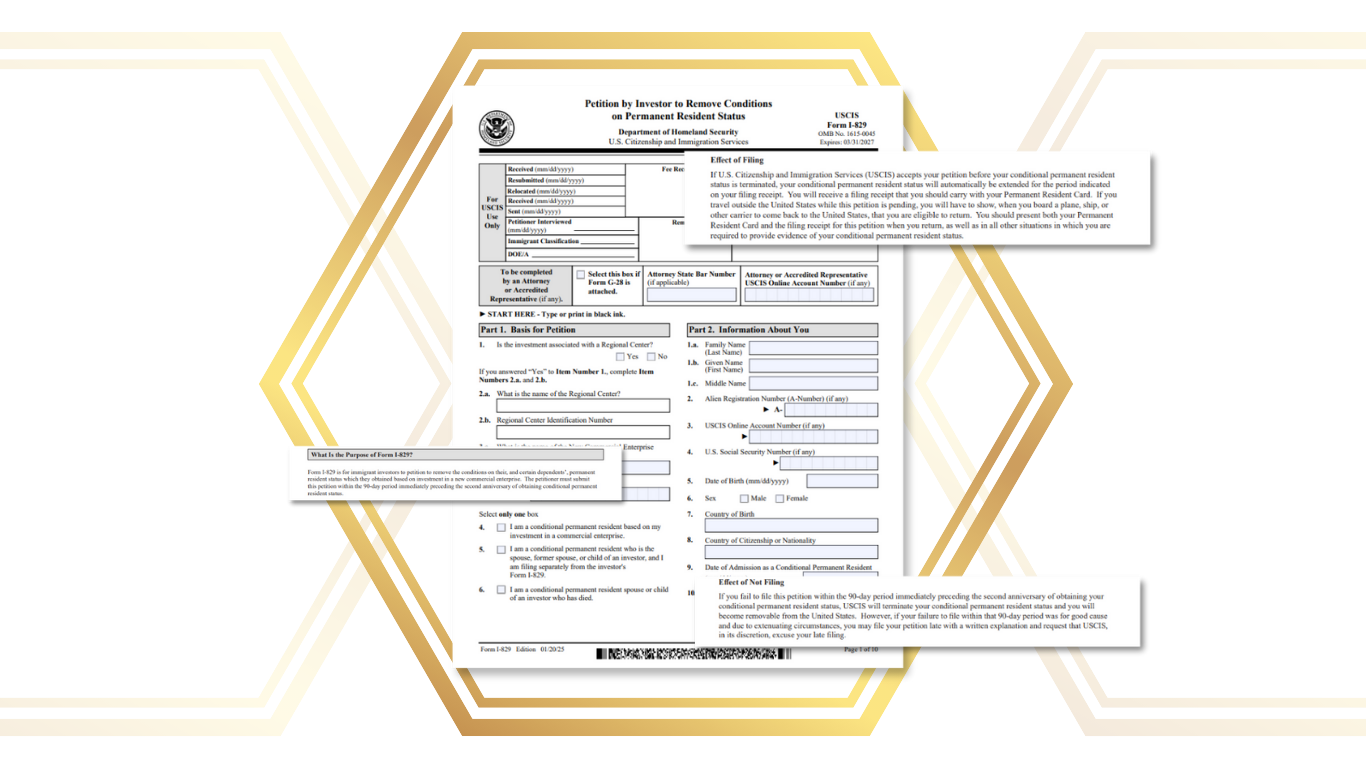
I-829: Petition by Investor to Remove Conditions on Permanent Resident Status
As previously mentioned in the Consular Processing section, the Conditional Green Card is for 2-years from entering into the United States. The applicant can begin the I-829 paperwork within 90 days of the conditional green card expiring. As an EB-5 Regional Center we mark the 90-day window one month in advance, so we can work on the supporting documents and completion of form I-829.
During this application, the EB-5 Regional Center will put together supporting documents to show case the applicant’s investment was at risk during their application process, the project created the 10 direct and indirect jobs, and the project used the funds for the specific Job Creation Entity ("JCE") the applicant invested in.
EB-5 Investment Requirements
Job Creation
Capital Investment
At Risk Capital Investment
Lawful Source of Funds
Obtaining Permanent Resident Status
Obtaining permanent resident status (the “Green Card”) in the United States is generally restricted to three paths: Employment-based, Family-based and Entrepreneur-based programs. Because the Family and Employment-based options are subject to long visa backlogs and other major obstacles, the EB-5 “Immigrant Entrepreneur” program has become one of the fastest and most reliable visa options offered by the United States.
With relaxed eligibility qualifications and a special reserve of 10,000 visas annually, the EB-5 program opens the door to permanent resident status to retirees, entrepreneurs, students, business owners, professionals and more. The EB-5 immigrant visa classification has many street names: such as the “Entrepreneur” visa, “Investor” visa and the “Jobs Creation” visa.
Congress created this program to encourage infusion of foreign capital to benefit the U.S. economy and exchange U.S. residency for job creation benefiting America workers. In simplest terms, the EB-5 program works like this:
- The U.S. Citizenship and Immigration Service (USCIS) will issue provisional visas to foreign entrepreneurs who seek to create at least 10 full-time, direct jobs for American workers.
- Every entrepreneur must create 10 new, full-time and permanent jobs in an America business (“new commercial enterprise”) that will remain in place during a 24-month period. That means the commercial enterprise will be required to provide to the USCIS payroll, tax and accounting records proving that he directly employs 10 workers. In addition, by “directly” employs the USCIS means these must be W-2 employees of the entrepreneur or his company.
- If the Immigrant fails to prove that he has created all 10 of these new, full-time and permanent jobs then the USCIS will cancel the immigrant visa and start deportation procedures to remove him and his family from the country.
- However, this strict job creation rule was significantly softened when the Congress created the new “EB-5 Regional Center” program.
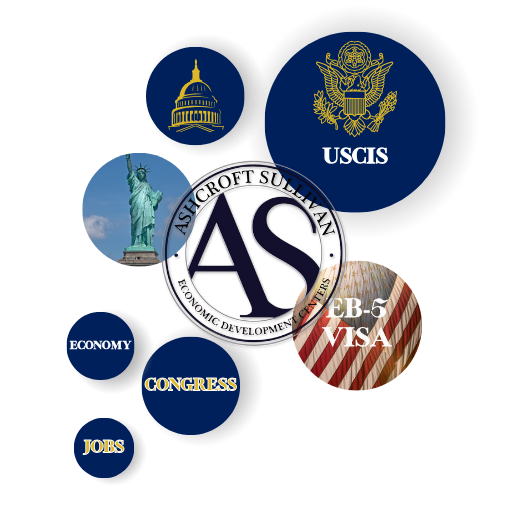
The Five W's of the EB-5 Visa Program
Who Controls the EB-5 Visa Program?
U.S. Congress
The EB-5 Program legislative foundation is set by Congress. Congress created the EB-5 Immigrant Investor Program in 1990. Furthermore, it is the government body that makes changes to the law that governs it. Other times U.S. Congress made changes to the EB-5 program was in 1992 and 2022. Even though it created the program and makes changes to the law, Congress does not administer or adjudicates the program.
United States Citizenship and Immigration Service
USCIS plays a crucial role in administering and adjudicating the petitions for the EB-5 Program. This agency is part of the Department of Homeland Security (“DHS”). United States Citizenship and Immigration Services approves or denies EB-5 projects, investors applications, and Regional Centers. In additon, it monitors the entire program making sure all parties are complying with the imigration rules.
What is an EB-5 Visa?
It allows foreign nationals who invest into New Commercial Enterprises (“NCE”) and Job Creating Entities (“JCE”) to obtain a green card for them and their family members under the age of 21 years old. It creates economic stimiluous and jobs in the United State, more specificly designated areas a EB-5 Regional Center can invest into.
What does EB-5 mean?
Emplyment-Based Fifth Preference. It is a U.S. visa category for immigrant investors seeking permanent green cards, and eventaully citizenship in the United States.

When and Why was the EB-5 Immigrant Visa Program Created?
1990
The EB-5 Immigrant Investor Program was created by congress in 1990. It was part of the Immigrant Act of 1990, which allows foreign investors to gain U.S. residency by investing in a New Commercial Enterpirse (“NCE”) that creates jobs in the United States. The U.S. government established the EB-5 Program to stimulate the economy by attracting foreign capital and creating jobs for American citizens and permanent residents.
1992
Fast forward to 1992, the Immigrant Investor Pilot Program (“IIPP”), also known as the Regional Center Program, was established. The U.S. government developed Regional Centers to make the investment more succesful, appealing, and streamlined for the investors. The purpose of a Regional Center is to make it more flexible for the applicant and derisk thier investment.
2022
At this time, the EB-5 Regional Center Program had a few month lapse while the industry waited for the U.S. government to update or continue the program as is. President Biden signed the EB-5 Reform and Integrity Act (“RIA”) on March 15 2022, which reauthorized the Regional Center Program, which updated the requirements and added new investors protection policies.
Where can an Applicant Invest into the EB-5 Program?
Direct Investment into a Project
EB-5 investors have the ability to invest directly into an approved EB-5 project, however, this comes with different requirements than investing through an EB-5 Regional Center. Projects have to create 10 direct jobs if investment is direct into the project. In addition, the investor has to have an active role in the business. This role can be day to day or high level policy making role like officer or board member.
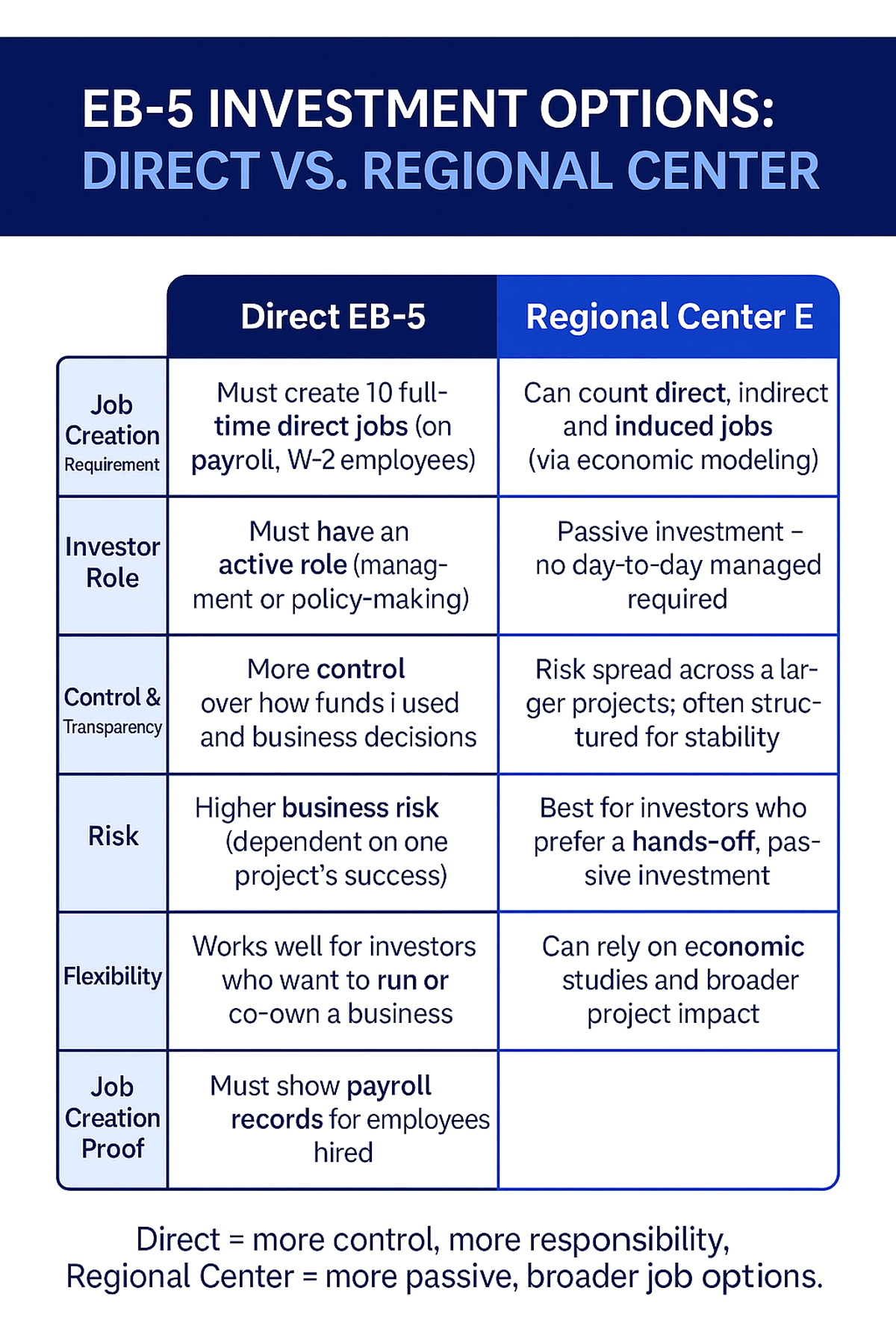
Through an EB-5 Regional Center
An EB-5 Applicant can invest their money through any approved Regional Center in the United States. The requirements for the investor is more flexible than a direct investment into a project. Utilizing an EB-5 Regional Center allows the applicant to become a passive investor, utilize direct, indirect, and current jobs, and invest into a larger project which lowers the risk of investment.
The Regional Center
A special designation issued by the USCIS called an “EB-5 Regional Center” (“RC”) provides several significant benefits to immigrants seeking residency through the traditional EB-5 program.
One of the most important advantages of working with a designated RC is relaxed job creation requirements – critical to obtaining and sustaining permanent residency. Typically, an immigrant must prove he or she created and sustained 10 new, direct employees over a 24- month period. Under the RC program, however, the immigrant can satisfy residency testing by showing indirect job creation. In other words, the immigrant does not need to show he or she directly employs any workers.
Another RC advantage is that immigrants may pool capital thereby reducing management responsibilities while increasing job creation results.
On October 5, 2012, President Obama signed into law a three-year extension of the EB-5 Regional Center program. This means that immigrants can safely obtain Green Card Status through the Ashcroft Sullivan Economic Development Center program through September 30 2015. While the EB-5 visa process has three major milestones, there are, of course, many smaller steps, which must be completed to reach the goal of residency. The below chart provides a more detailed overview of this process.
Mobile Development Coming Soon
Day(s)
:
Hour(s)
:
Minute(s)
:
Second(s)
Please use a Desktop to look at our website until our mobile development is completed.
Tablet Development Coming Soon
Day(s)
:
Hour(s)
:
Minute(s)
:
Second(s)
